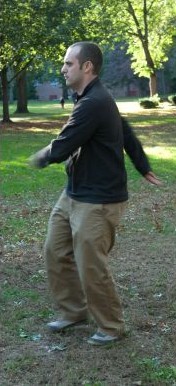The Three Swings from Energy Gates are some of the most challenging exercises to do well in the entire Energy Arts curriculum. You have to relax, maintain good alignment, and coordinate stepping and turning while moving faster than most other qigong exercises.
Let's talk a little bit about why the Three Swings are important and what you need to integrate to do them well.
Getting Started with the Three Swings
In the Tai Chi Classics, it says, "the motion should be rooted in the feet, released through the legs, controlled by the waist and manifested through the fingers." Think of practicing the swings as a way to test this concept. You will get much clearer feedback from the swings about how the motion you generate from the feet travels out to your fingertips than you will from solo form practice.
To do the swings well, you need to do these three things:
- Relax Your Arms
- Sink Your Weight
- Open Your Kwa
When you let the arms go completely and begin to turn from the kwa, you then focus on alternately sinking the weight down one leg and then the other. In that sense, the First Swing is a natural extension of what you do in your Standing practice and then in Cloud Hands.
What's new in the First Swing, though, is that you will begin to speed up the alternating sinking (that causes your weight shift from side to side), so that the arms begin to swing. Until you start building momentum, though, the arms should just hang by your sides.
And that's where the swings get interesting...
Where the Swings Get More Complicated
As a series, each of the swings is designed to build on the previous one. Swing by swing there is more complexity in terms of:
- Stepping
- Rhythm
- Timing
In the First Swing, you fold the kwa to turn into the weighted leg. In the Second Swing, you unfold the kwa to turn away from the weighted leg. In the Third Swing, you add a vertical kwa pump to the stepping pattern of the Second. Each of these in changes in stepping alters the rhythm and the timing.
The goal of moving from one to the next swing is to progressively build your internal connections, up through the spine and out the arms. In other words, you can see how each swing activates the internal connections in the body based on where the arms will go when you do the stepping correctly.
Look at the arm movement in each of the swings in this video:
You can see how, swing-by-swing, the arms move higher. That is due to the stepping and shifting patterns described above.
As you practice the swings over time, your energy will rise and fall with the motion of the arms. You learn to bring it up and down the body effortlessly, smoothing out stuck points as you improve your shifting, timing, and stepping.
If you're used to doing slow-motion qigong and tai chi practices, the swings can be very challenging because they are so dynamic. The payoff, though, is that you can take the feeling of integration that you get from being still or moving slowly and carry it over into more active practices. You still get the benefits of repetition and rhythm doing the swings, so it really is a bridge between stillness and ever-changing movement. Enjoy!


Share this post
Twitter
Google+
Facebook
Reddit
LinkedIn
StumbleUpon
Pinterest
Email